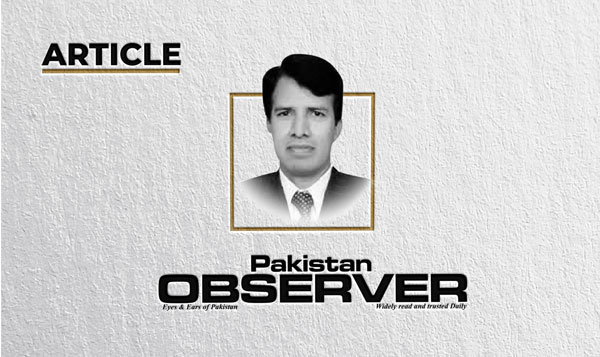Dynamism of Paigham-i-Pakistan
THE dynamic narrative of Paigham-i-Pakistan, conceived in 2018 is in line withthe teachings of Islam; the very basis of Pakistan.
Besides, this national narrative is a true reflection of the vision of father of nation, Quaid-i-Azam Muhammad Ali Jinnah. The Quaid himself was the greatest advocate of the teachings of the Holy Prophet (PBUH).
In July 1942, an American press representative asked Quaid-i-Azam Muhammad Ali Jinnah, “whether the Muslims were a nation or not”.
The Quaid said, “We are a nation with our own distinctive culture and civilisation, language and literature, art…
” Unfortunately, after attaining the status of an independent state in the form of Pakistan and owing to early death of founding father, there remained a crisis of national integration in Pakistan, which has severely affected its political stability, social integration and economic stability.
In the absence of a national unity and integration there remained challenges for the national security of Pakistan.
In a way, there is a direct relationship between national unity (national integration) and national security.
Over the years, the extremism and terrorism erupted in the traditionally peaceful society of Pakistan which harmed Pakistan in all aspects; social, political, economic and above all the ideological basis of the country.
This all happened in the absence of a true nationalistic narrative which could have catered for all aspects.
In the form of Paigham-i-Pakistan, a nationwide narrative was formulated to determine the future course of action.
Paigham-i-Pakistan is a message of social dynamism, political engagement and economic affluence.
It begins with the broader message of peace, which is considered as the basis for achieving all other aspects.
Indeed, Pakistan was the worst sufferer of extremism, radicalization and militancy which erupted towards the beginning of 21st century, after the unfortunate incidence of 9/11.
The militancy had destroyed the very social fibre of Pakistani society with overwhelming trends of intolerance and economic melt-down.
In last two decades, Pakistan suffered over 85000 human losses (deaths) besides thousands sustained serious injuries, as a result of continuous militancy by TTP and other militants.
Besides this, there have been serious impacts of the terrorism on the economy and society of the state in last two decades.
As per the estimates of Government, Pakistan lost over 129 billion USDs in term of its economy.
The industrial sector suffered huge losses and economic activities educed substantially during these long-years.
In a hopeless situation where terrorism was rampant in Pakistan, the armed forces of Pakistan took decisive steps against the terrorism and defeated the huge network of terrorists spread over entire Pakistan.
It was indeed a gigantic task, since there were many international and regional states, behind these terrorist groups, waging war against Pakistan.
In the fight against terrorism, the resilient Pakistani nation stood behind its armed forces in the national fight against terrorism.
The terrorist networks, operating in Pakistan were comprehensively entrenched and were being supported from all over; using Afghan soil as their harbouring site.
The international forces which remained in Afghanistan for two decades failed to achieve the stated objectives; defeating the Afghan Taliban.
Rather, they met the humiliating defeat in this campaign and finallyhad to leave Afghanistan in despondency, handing over the country to their rivals; Taliban who took over the country in August 2021.
Since then, there are new threats emanating from Kabul for the region. Whereas the security forces of Pakistan combated the militancy in physical domain, the wider message of Paigham-i-Pakistan worked well to change the militant mind-set existed in a class of Pakistani society.
As a result of these two parallel campaigns, the militancy reduced to its lowest. As per Global Terrorism Index, Pakistan recorded its lowest number of terror-related deaths in 2019 and 2020, ever since the start of this menace in 2002.
Comparing 2018, this was a 45% decline, a great achievement indeed. As per the new database of the Global Terrorism Index (GTI), Pakistan moved down to 7th position from its previous 5th position among the states most affected by terrorism.
GTI is a comprehensive study, undertaken each year accounting for world-wide direct and indirect impact of terrorism.
Though there has been a decline in the incidents of terrorism in Pakistan, yet the threats emanating from terrorism are not over.
It is a temporary pause, since the security forces and intelligence network of Pakistan (ISI and MI) have effectively countered these terrorist financers, abettors and those who planned this form of warfare against Pakistan.
Now, these regional and international forces are adopting new strategies to defame and undermine the state of Pakistan and its institutions of national security through hybrid warfare.
This is an indirect warfare against Pakistan, involving the masses, political forces, media and vested groups through changing the perception and narratives.
The new form of warfare is more difficult to be tackled and countered in physical domain, since it does not involve security forces alone, rather the target is a wider zone the masses and their perceptions about state and state apparatus.
The emerging threats from this warfare are broader in scope, deeper in impact, higher in planning and hazardous in magnitude.
Pakistan needs a fresh approach to debate the scope and dynamics of new forms of militancy and radicalization emanating from the horrors of hybrid warfare.
Paigham-i-Pakistan provides comprehensive responses to all the challenges which deal with the perception domain; the most needed aspect in the contemporary phase of Pakistan.
This national narrative encompasses a clear course of action in line with the global norms and international best practices, accepted by wider global community.
— The writer is Professor of Politics and IR at International Islamic University, Islamabad.










